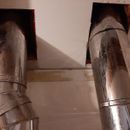Water Leaks in Cathedral Ceiling with Chimney
Hi all!
I’m by no means a contractor, so some descriptions may be wrong…so bare with me!
I have cathedral ceiling in a house we bought 4 years ago and had noticed water running down the beams and staining the walls…I pulled my head out of the sand and dealt with it last fall…long story short we have replaced a large section of ceiling. My guess, was when the previous owner put a metal roof over the old shingle roof, they hacked up near the selkirk boots…and caused a couple years of leaking…in a space that had no ventilation. 0 rafter vent installed anywhere and the bats of insulation jammed up into the 3/8″ holes drilled in the cross support beams halfway up ceiling. So demoed the entire ceiling, had roofer in to replace the rotted sheathing and ridge. Ran rafter vent from soffit to ridge…vapor barrier with acoustic caulking and then drywall etc.
I had issues with the roofing job that was done, caulking old boots instead of simply replacing…so still had leaking after all that. Had new roofer in and redo the boots and it’s now tight when it rains….however I’m still getting drips. I’ve not insulted the selkirk area inside, as was waiting to see if new repairs held…
They are holding and I’m getting drips coming down from the Rafer vent…see picture of uninsulated selkirk area…would there being warm air from the house being pulled up and mixing with he cold air at the roof ridge and condensing back down?
If so, and insulation around the selkirks is going to be the fix…can I just do with pipe insulation? Or do I have to do a selkirk mounting box? I’d rather not have to do the box, and hope can get by with wrap insulation, keeping it off the underside of roof, to allow continuous airflow up the rafter vent, and then board it in with caulking and collar.
Or is this still a roofer issue with water still getting in….I live in Atlantic Canada and we see a freeze thaw like once a week this winter…and like I said, we’ve had monsoons that have held with the latest repairs , but when the weather shifts back to cold…or when there is snow left around the chimney area after a storm…( when I look up at chimney area after storm…and most of the snow has slid off, there is still snow left there and it seems like it’s got some slush properties leaving it on the roof…like it’s getting warmed from below…which would make sense that all my hot air from the house is leaving out the area without insulation) it stills drips…and is causing damage to the dry wall seams.
Any thoughts would be awesome and appreciated!! Stretching my head over this one
Craig
GBA Detail Library
A collection of one thousand construction details organized by climate and house part










Replies